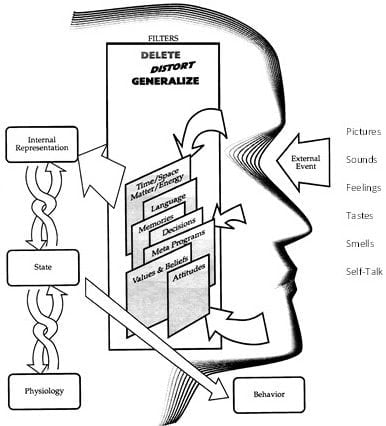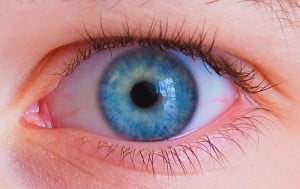NLP Communication Model
 Let’s simplify the NLP Communication Model and see what we can do to cut through the jargon. Big picture:
Let’s simplify the NLP Communication Model and see what we can do to cut through the jargon. Big picture:
Originally conceived and developed by John Grinder and Richard Bandler, NLP or Neuro Linguistic Programming began as a model of how we communicate and interact with ourselves and others. The NLP communication model explains how we process the information that comes in from outside us and what we do with it inside.
In NLP, we believe that “The map is not the territory,” so the internal representations that we make about an outside event are not essentially the event itself. What happens is that there is an external event and we run that event through our internal processing. We make an Internal Representation (I/R) of that event. The I/R of the event then combines with a physiology to create a state. The word “State” refers to the internal emotional state of the individual — happy, sad, motivated etc.
Did you ever notice that people treat their perceptions differently? Some people have to “see” certain relationships between things, where others have to have it explained or so they can “hear it”. Still others have to “get a grasp or a feeling” for the relationships. This is the essence of the NLP Communication Model.
The words, Internal Representation (I/R) include our internal pictures, sounds and dialogue, our feelings, and tastes and smells. So, what happens is that an event comes in through our sensory input channels, which are:





OK. So, the external event comes in through the sensory input channels and is filtered and managed by our neurology. As we manage the perception of the event, we delete, distort, and generalize the information according to the following processes that filter our perception.
Components of the NLP Communication Model
Deletion:
Deletion occurs when we selectively pay attention to certain aspects of our experience and not others. We overlook or omit others. Without deletion, we would be faced with too much information. Maybe you already are overloaded with information and you feel like you have too much.
Distortion:
Distortion occurs when we misrepresent reality by making shifts in our experience of sensory data. In Indian philosophy, there is a well-known story of distortion in the rope versus snake analogy. A man walking along the road sees what he believes to be a snake and yells “SNAKE.” However, upon arriving at that place he is relieved as he discovers that what he sees only a piece of rope.
Distortion is an important component to the NLP Communication Model and can be used to motivate ourselves. Motivation can happen when we actually misrepresent, change or garble the material that has come into our neurology. The information has been changed by one of our filtering systems.
Generalization:
Finally, comes generalization, and here we draw global conclusions based on one or two experiences. Do you know someone who has one experience and forms an opinion about all similar experiences? EG: “I hate all Indian music because I have heard Ravi Shankar and did not like it.”
Usually, the conscious mind can only handle seven (plus or minus 2) pieces of information at any given time. It gets overloaded. So, we tend to oversimplify, make decisions and set attitudes based on insufficient information. It’s critical to understand this in terms of the larger NLP Communication Model. Generalization is very common in the world today. Everybody does it. It’s is a result of the digital information causing information overload and taking over sensibility.
Of course, we all know many people can’t even handle this number, and I know you know people who can only process “1 (plus or minus 2).” How about you?
Try this: Can you name more than 7 products in a given product category, say cigarettes? Most people will be able to name 2, maybe 3 products in a category of low interest and usually no more than 9 in a category of high interest. There is a reason for this.
If we did not actively delete information all the time, we would end up with much too much information coming in. In fact, you may have even heard that psychologists say that if we were simultaneously aware of all of the sensory information that was coming in, we would go crazy. That is why we filter the information.
At its best, generalization is one of the ways that we learn—- taking the information we have and drawing broad conclusions about the meaning of those conclusions. So, the question is, when two people have the same stimulus, why do they not have the same response? The answer is, because we delete, distort, and generalize the information from the outside that comes in from our senses based on one of five filters. The filters of the NLP Communication Model are Meta Programs, Belief Systems, Values, Decisions, and Memories.
Meta-Programs:
The first of these NLP filters is Meta Programs. Knowing someone’s Meta Programs can help you clearly and closely predict people’s states, and therefore predict their actions and behaviors. Meta Programs are clearly outlined in Tad James book Time Line Therapy, and the Basis of Personality One important point about Meta Programs: they are not good or bad, they are just the way someone handles information.
Values:
The next filter in NLP is Values. Values are essentially an evaluation filter. They are how we decide whether our actions are good or bad, right or wrong and how we feel about our actions. Values are arranged in a hierarchy with the most important one typically being at the top and lesser ones below that. They are also discussed in Tad James book Time Line Therapy, and the Basis of Personality. Each of us has a different NLP Communication model of the world (an internal model about how the world is), and our Values are the result of our model of the world. When we communicate with ourselves or someone else, if our model of the world conflicts with our values or someone else’s values, then there is going to be a conflict. Richard Bandler says, “Values are those things we don’t live up to.”
Values are what people typically move toward or away from (see Meta Programs). They are our attractions or repulsions in life. They are basically a deep, unconscious belief system about what’s important, and Values can change with context too. That is, you probably have certain values about what you want in a relationship and what you want in a business. Your values about what you want in one and in the other may be different. And actually, if they’re not, it’s possible that you may have trouble with both. Since values are context related, they may also be state related.
Beliefs:
The next filter is beliefs. Beliefs are generalizations about how the world is. Beliefs are the assumptions that we have about the way the world is that either create or deny personal power to us. So, beliefs are essentially our on/off switch. In the process of working with someone’s beliefs, it’s important to discover what beliefs they have that cause them to do what they do. We also want to find out the disabling beliefs, the ones that do not allow them to do what they want to do.
Memories:
The fourth filter is our memories. In fact, a number of psychologists say that the present plays a very small part in our behavior. They believe that as we get older, our reactions in the present are more and more just reactions to gestalts (collections of memories that are organized in a certain way) of past memories, We can use Time Line Therapy® to make changes in our memories for a positive result.
Decisions:
The fifth filter is the decisions that we have made in the past. Decisions may create new beliefs, or may just affect our perceptions through time. The problem with many decisions is that they were made either unconsciously or at a very early age, and are forgotten. But the effect is still there. We can also make changes to the limiting decisions in our past using Time Line Therapy® techniques.
These five filters will determine how we internally represent an event that is occurring now. It is our internal representation that puts us in a certain state, and creates a certain physiology. The state in which we find ourselves, will determine our behavior, and the NLP Communication Model will determine how we process all the information from the outside world.
Fill in our form now and take advantage of this amazing opportunity to learn these techniques to improve your life and the lives of others as you do. Learn how to achieve your goals with The Tad James Company and learn how to improve people’s lives better than they currently are.
Call for help:
US Office (calling from outside the US):
1-702-440-4823
AU Office: 1-800-133-433
AU Office (calling from outside AU):
+61 (0)2 9221 9221
